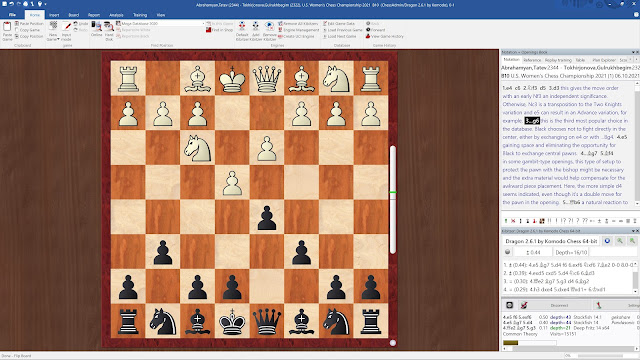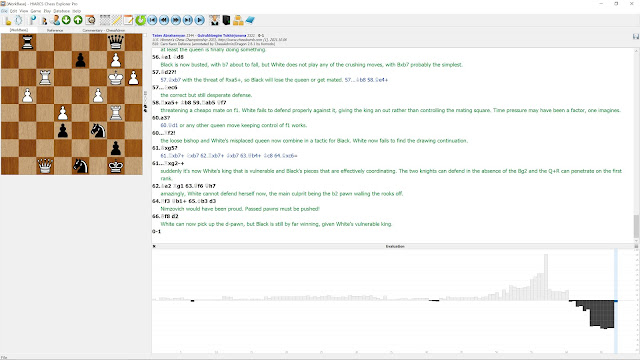Computer resources: HIARCS Chess Explorer Pro
As a follow up to the Chess Computing Resources post, here I'll highlight the recent release (January 2022) of HIARCS Chess Explorer Pro (HCE for short). I was made aware of it in a blog post by NM Hans Schut, then decided to try it for myself, as a replacement for using ChessBase 15 (CB15). One of the key features is the program's ability to read (and convert) CB files to its own format, so it can genuinely replace the use of ChessBase without losing access to previous work.
I had been tired for a long time of ChessBase's long-standing annoying bugs and GUI limitations/quirks, but the final push to switch came when I was analyzing the last commentary game (Abrahamyan - Tokhirjonova from the 2021 US Women's Championship). A complicated, 66-move middlegame maneuvering struggle, this required more time than usual to go through, and during one analysis session the ChessBase window crashed and I lost over 2 hours of work. Most modern programs these days have an auto-save feature for just this reason, but unfortunately not ChessBase.
As with any new program, it took a little experimentation to get the HCE Pro GUI setup the way I wanted and figure out how to do things like set the chess engine parameters. For most of my chess analysis/study needs, I want to have visible:
- A large board display
- Notation window, where variations and notes are entered
- Engine analysis window
- Reference database window
- As can be seen in the top screenshot, there is easily room for the reference tree window ("Tree Explorer") at the bottom right in HCE. In my previous CB15 setup, it's a separate tab in the notation window.
- Adding "Book Explorer" will let you view either local or online book trees, which are easily selectable from the buttons on the window. I tend not to use this feature much, instead relying on the reference database and engine evaluation, but for others the book availability can be an important added feature for analysis.
- Notes and variations in the notation are displayed more readably in HCE when paired with a large board, although I think CB15 does a better job of visually displaying multiple sub-variations in a unique way.
- The engine window ("Analysis Explorer") has all the necessary information at a glance and you can adjust engine settings using the icons. However, version 1.0 has these setting adjustments as temporary only, so to save them for the next session, you'll need to go to Edit - Preferences - Engines and double-click on the engine name to permanently change its parameters.
- The tabbed main window in HCE allows for easier switching between open databases. You can also toggle on/off the current database game list at the bottom of the screen ("Game Explorer").
- The one quirk for me with HCE is that the board is on the left of the screen and the right side columns can't be further resized beyond what you see above; so if I want the board centered for my vision, I need to use the hack of physically moving my monitor over to the right. This is a relatively minor thing, however.





No comments:
Post a Comment